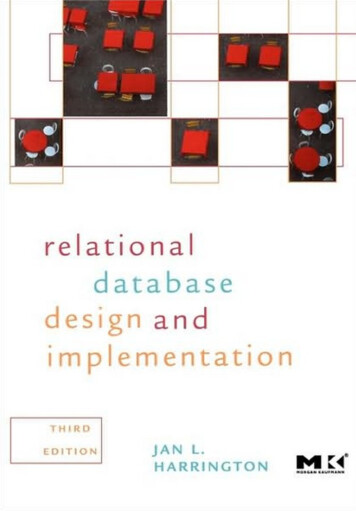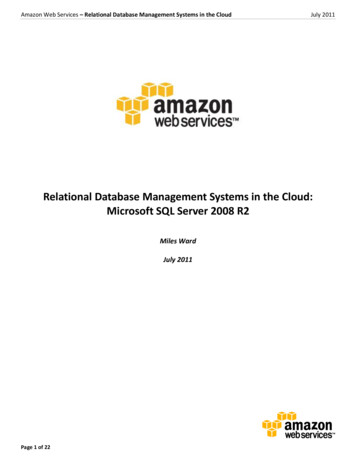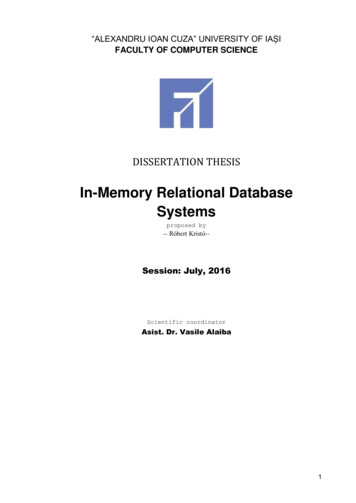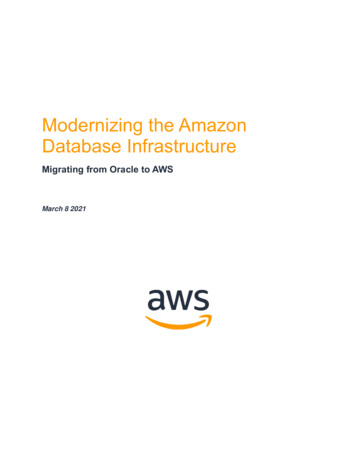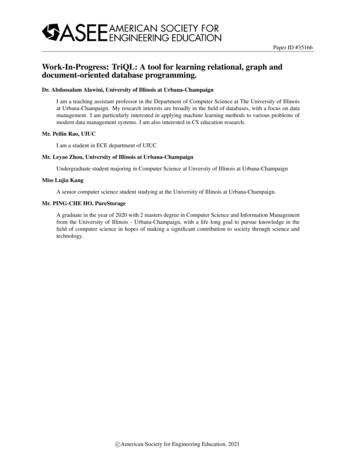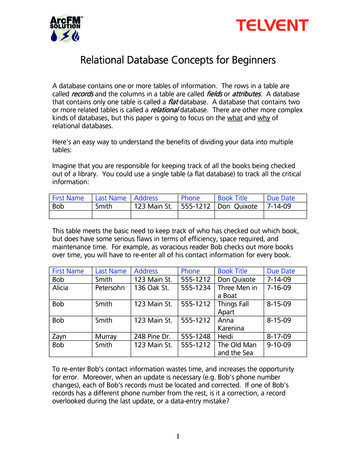
Transcription
Relational Database Concepts for BeginnersA database contains one or more tables of information. The rows in a table arecalled records and the columns in a table are called fields or attributes. A databasethat contains only one table is called a flat database. A database that contains twoor more related tables is called a relational database. There are other more complexkinds of databases, but this paper is going to focus on the what and why ofrelational databases.Here’s an easy way to understand the benefits of dividing your data into multipletables:Imagine that you are responsible for keeping track of all the books being checkedout of a library. You could use a single table (a flat database) to track all the criticalinformation:First NameBobLast NameSmithAddress123 Main St.Phone555-1212Book TitleDon QuixoteDue Date7-14-09This table meets the basic need to keep track of who has checked out which book,but does have some serious flaws in terms of efficiency, space required, andmaintenance time. For example, as voracious reader Bob checks out more booksover time, you will have to re-enter all of his contact information for every book.First NameBobAliciaLast NameSmithPetersohnAddress123 Main St.136 Oak St.Phone555-1212555-1234BobSmith123 Main St.555-1212BobSmith123 Main St.555-1212ZaynBobMurraySmith248 Pine Dr.123 Main St.555-1248555-1212Book TitleDon QuixoteThree Men ina BoatThings FallApartAnnaKareninaHeidiThe Old Manand the SeaDue Date7-14-097-16-098-15-098-15-098-17-099-10-09To re-enter Bob’s contact information wastes time, and increases the opportunityfor error. Moreover, when an update is necessary (e.g. Bob’s phone numberchanges), each of Bob’s records must be located and corrected. If one of Bob’srecords has a different phone number from the rest, is it a correction, a recordoverlooked during the last update, or a data-entry mistake?1
These problems can be decreased by normalizing our data – in other words, dividingthe information into multiple tables with the goal of having “a place for everything,and everything in its place.” Each piece of information should appear just once,simplifying data maintenance and decreasing the storage space required.PATRONS TABLEFirst NameBobAliciaZaynLast NameSmithPetersohnMurrayAddress123 Main St.136 Oak St.248 Pine Dr.Phone555-1212555-1234555-1248CHECKOUT TABLEBook TitleDon QuixoteThree Men ina BoatThings FallApartAnnaKareninaHeidiThe Old Manand the SeaDue Date7-14-097-16-098-15-098-15-098-17-099-10-09Now that the data are arranged efficiently, we need a way to show which records inthe PATRONS table correspond to which records in the CHECKOUT table – in otherwords, who checked out which book. Instead of repeating everything we knowabout a patron whenever he checks out a book, we will instead give each librarypatron an ID, and repeat only the ID whenever we want to associate that personwith a record in a different table.PATRONS TABLEPatron ID123First NameBobAliciaZaynLast NameSmithPetersohnMurrayAddress123 Main St.136 Oak St.248 Pine Dr.Phone555-1212555-1234555-1248CHECKOUT TABLEPatron ID121131Book TitleDon QuixoteThree Men in a BoatThings Fall ApartAnna KareninaHeidiThe Old Man and the Sea2Due Date7-14-097-16-098-15-098-15-098-17-099-10-09
Now the PATRONS and CHECKOUT tables can be related (how relationships areformally declared in various database software is beyond the scope of this paper).At this point, we need some new terms to talk about our related tables.The primary key is a field whose values are unique in this table, and so can be usedas identifiers for the records (multi-field or composite primary keys are beyond thescope of this paper, and are unlikely in an ArcGIS geodatabase). In table PATRONS,the Patron ID field is the primary key and so its values must remain unique. Forexample, the value “2” can appear only on one record - Alicia’s - and Alicia canhave only one Patron ID - “2.”Is the Patron ID field in table CHECKOUT the primary key? We can see that itcontains duplicate values, so the answer is No. If Patron ID were the primary key forCHECKOUT, each person would only be permitted to check out one book, andafterward would be forbidden to check out any more books, ever.So if Patron ID is not the primary key for table CHECKOUT, which field is? We can’tmake Book Title the primary key, or we’d have a similar problem – each book couldonly be checked out once, and afterward no one would be permitted to check itout ever again. We can’t make Due Date the primary key, or else only one bookcould be due each day. Since none of the existing fields works as a primary key,we will add a new field to hold an identifier for each record. We could name thisfield Checkout ID, or we could follow ESRI’s convention of giving all primary keyfields exactly the same name: ObjectID.PATRONS TABLEObjectID123First NameBobAliciaZaynLast NameSmithPetersohnMurrayAddress123 Main St.136 Oak St.248 Pine Dr.Phone555-1212555-1234555-1248CHECKOUT TABLEObjectID123456Patron ObjectID1211313Book TitleDon QuixoteThree Men in a BoatThings Fall ApartAnna KareninaHeidiThe Old Man and theSeaDue Date7-14-097-16-098-15-098-15-098-17-099-10-09
Naming every primary key field “ObjectID” does make it easy to tell at a glancewhich field uniquely identifies the records in this table. We can also use this namingconvention to provide hints about which fields are related. For example, PatronObjectID in CHECKOUT is related to ObjectID in PATRONS.To further increase efficiency, decrease required space, and improve ease ofmaintenance, we can separate the book information into its own table.PATRONS TABLEObjectID123First NameBobAliciaZaynLast NameSmithPetersohnMurrayAddress123 Main St.136 Oak St.248 Pine Dr.Phone555-1212555-1234555-1248CHECKOUT TABLEObjectID123456Patron ObjectID121131Book ObjectID163524Due S TABLEObjectID123456TitleDon QuixoteHeidiThings Fall ApartThe Old Man and theSeaAnna KareninaThree Men in a BoatAuthorMiguel CervantesJohanna SpyriChinua AchebeEarnestHemingwayLeo TolstoyJerome K. JeromeYear160518801958195218731889Now ObjectID in BOOKS is related to Book ObjectID in CHECKOUT.When two tables have an unequal relationship, we call the independent table theparent and the dependent table the child. You can identify the parent table bydetermining which table could contain a record without needing a correspondingrecord in the table on the other side of the relationship. For example, is it possibleto have an unpopular library book which never gets checked out? Yes. Is itpossible to check out a book that doesn’t exist? No. Since BOOKS can contain4
records that aren’t referenced by CHECKOUT, BOOKS is the parent in thisrelationship, and CHECKOUT is the child.If somehow the child table contains a record that does not have a correspondingrecord in the parent table, that record is called an orphan. Orphaned records are aproblem that generally requires attention from the database administrator.Another way to identify the child table is to find the field which refers to the othertable’s ObjectID. BOOKS does not contain an ObjectID field for the CHECKOUTS,but CHECKOUTS does contain a field to store Book ObjectIDs. Therefore,CHECKOUTS is the child table in this relationship.The last new concept to consider is cardinality, which describes how many recordsin one table can be related to records in another table. Two tables might have acardinality of 1-1 (one to one), 1- ! (one to many), 1-3 (one to three), ! - ! (manyto many), etc. The PATRONS – CHECKOUT relationship has a 1- ! cardinality,because 1 patron may have any number of checkouts, from zero to infinity. Putanother way, the CHECKOUT – PATRONS relationship has a cardinality of ! - 1. Ifthe cardinality of PATRONS – CHECKOUT were 1-1, then each patron could checkout only one book. If it were ! - !, then several patrons together might share jointresponsibility for one or more checkouts.The BOOKS – CHECKOUT relationship is also 1 - !, since one book may be checkedout multiple times.If we really were designing the data model (tables, fields, relationships, etc.) for alibrary, we would continue by separating even more data (such as the authors) intoother tables until the model was as efficient as possible. Since we are modelingutility data instead, let’s see how these ideas apply to meters and service points:SERVICE POINT TABLEObjectIDShapeType123 Shape Shape Shape Single ResidenceMulti-familySingle ResidenceMETER TABLEObjectID123456Address123 Main St.136 Oak St. #3136 Oak St. #4248 Pine Dr.136 Oak St. #2136 Oak St. #1Service Point Object iveInstallationDate2-4-19743-1-19802-12-1998
The SERVICE POINT table stores one record per location, but each location couldhave multiple Meters (for example, all the meters for an apartment building may beaccessible from the same closet). The relationship between SERVICE POINT andMETER is 1-! (one Service Point can include any number of meters). METER is thechild table, because it contains a field to store Service Point ObjectIDs.Also notice that SERVICE POINT contains a Shape field, but METER does not.ArcGIS stores a map feature’s dimensions and location in the Shape field (althoughthe specifics of this information may be hidden under the generic alias Shape ).The presence of a Shape field in the SERVICE POINT table tells us that Service Pointsare features – objects that can be displayed on a map. The absence of a Shape fieldin METER tells us that Meters are ordinary objects that cannot be displayed on amap.When several related objects are likely to be in close proximity, having a Shape fieldonly at the parent level decreases map clutter. For example, a high-rise apartmentbuilding might have one Service Point and 80 Meters. It is much more efficient tosketch one Service Point and then create 80 unmapped Meters related to thatService Point, than to sketch 80 individual Meters. In the same way, whensketching a three phase transformer, it is usually better to sketch one parentTransformer, which relates to three child Transformer Units (one per phase).TRANSFORMER TABLEObjectID123Pole LocationIDSE143232SE14355TRANSFORMER UNIT 112336Type3-Phase Overhead1-Phase Overhead2-Phase Overhead
How does all this look in ArcFM and ArcMap?The green triangle shown here is one way a three-phaseoverhead Transformer might be symbolized on the map(this Transformer is on a 35-foot class 3 Pole with anAnchor Guy). Although only one symbol appears on themap, if we select this Transformer we can see that it isrelated to three Transformer Units – one for each phase.We can also see that the Transformer has attributes, andeach of the Transformer Units has its own attributes. TheTransformer has a Shape field where its geographiclocation is stored. The Transformer Units do not have a Shape field, so we knowthey cannot appear on the map.A list of all related tables (both parents and children) appears below the feature.Thus we can see that Transformers can be related not only to Transformer Units,but also Electric Stations, Load Tap Changers, and so on. Whenever a recordrelated to the selected feature exists in one of these tables, an expandableplus/minus box appears to the left. Since Transformer Unit is the only line with aplus/minus box, we know that this particular Transformer currently has relatedrecords only in the Transformer Unit table.7
The small white box shown here is one way a Service Pointmight be symbolized on the map. This single Service Pointincludes twenty Meters – one for each unit in this apartmentbuilding. Since only the Service Point has a Shape field, only itcan be shown on the map. The Meter records store all theinformation we need to track for each customer, but cannotappear on the map.And now you know the fundamental database concepts of primary keys, parents,children, cardinality, and relationships, and their application to utility ArcGISdatabases.8
Relational Database Concepts for Beginners A database contains one or more tables of information. The rows in a table are called records and the columns in a table are called fields or attributes. A database that contains only one table is called a flat database. A database that contains two or more related tables is called a relational database.

